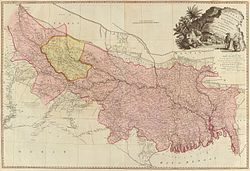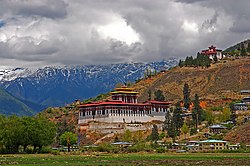Bhutan; Dzongkha: འབྲུག་ཡུལ་, romanized: Druk Yul),
officially known as the Kingdom of Bhutan (Dzongkha: འབྲུག་རྒྱལ་ཁབ་, romanized: Druk Gyal Khap), is
a landlocked country in South Asia. Located in the Eastern Himalayas, it is
bordered by Tibet in the north,
the Chumbi Valley of Tibet
and the Indian states of
Sikkim and West Bengal in the
west, and the Indian states of Assam, West Bengal and Arunachal Pradesh in
the south and east. Bhutan is geopolitically in South Asia and is the region's
second-least-populous nation after the Maldives. Thimphu is its capital
and the largest city, while Phuntsholing is its
financial center.

Bhutan's independence has endured for centuries. It has never been
colonized in its history.
Situated on the ancient Silk Road between
Tibet, the Indian
subcontinent and Southeast
Asia, the Bhutanese state developed a distinct national
identity based on Buddhism.
Headed by a spiritual leader known as the Zhabdrung
Rinpoche, the territory comprised many fiefdoms and
was governed as a Buddhist theocracy. Following a civil war in the 19th
century, the House
of Wangchuck reunited the country and established relations
with the British
Empire. After the end of the British Raj,
Bhutan fostered a strategic partnership with India during the rise of Chinese
communism; it has a disputed border with China. In the early 1990s, the
government deported much of the country's Nepali-speaking Lhotsampa minority,
sparking a refugee crisis in nearby Jhapa, Nepal. In
2008, Bhutan transitioned from an absolute
monarchy to a constitutional
monarchy and held the first election to the National Assembly of Bhutan. The National Assembly is part of
the bicameral parliament of the Bhutanese
democracy.

The country's
landscape ranges from lush subtropical plains in the south to the sub-alpine
Himalayan mountains in the north, where there are peaks higher than 7,000
metres (23,000 ft). Gangkhar
Puensum is Bhutan's highest peak and may also be the highest
unclimbed mountain in the world. The wildlife
of Bhutan is notable for its diversity.
In South Asia, Bhutan
ranks first in economic
freedom, ease of doing business and peace and
is the least corrupt country in the region as of 2016. It
continues to be a least
developed country, but expects to graduate from this status by 2023.
Hydroelectricity accounts for most of its exports. The
government is a parliamentary democracy; the head of state is
the King of Bhutan, known as the "Dragon King."
Bhutan maintains diplomatic relations with 52 countries and the European
Union, but does not have formal ties with the five permanent members
of the United Nations Security Council. It is a member of the United
Nations, SAARC, BIMSTEC and the Non-Aligned
Movement. The Royal
Bhutan Army maintains a close relationship with the Indian
Armed Forces and Bangladesh
Armed Forces.
Bhutan is also
notable for pioneering the concept of Gross
National Happiness.
History

 Stone tools, weapons, elephants, and remnants of large stone structures provide evidence that Bhutan was inhabited as early as 2000 BC, although there are no existing records from that time. Historians have theorized that the state of Lhomon (literally, "southern darkness"), or Monyul ("Dark Land", a reference to the Monpa, the aboriginal peoples of Bhutan) may have existed between 500 BC and AD 600. The names Lhomon Tsendenjong (Sandalwood Country), and Lhomon Khashi, or Southern Mon (country of four approaches), have been found in ancient Bhutanese and Tibetan chronicles.
Stone tools, weapons, elephants, and remnants of large stone structures provide evidence that Bhutan was inhabited as early as 2000 BC, although there are no existing records from that time. Historians have theorized that the state of Lhomon (literally, "southern darkness"), or Monyul ("Dark Land", a reference to the Monpa, the aboriginal peoples of Bhutan) may have existed between 500 BC and AD 600. The names Lhomon Tsendenjong (Sandalwood Country), and Lhomon Khashi, or Southern Mon (country of four approaches), have been found in ancient Bhutanese and Tibetan chronicles.
The dzong in the Paro valley, built in 1646.
Buddhism was first introduced to Bhutan in the 7th century AD. Tibetan king Songtsän Gampo (reigned 627–649), a convert to Buddhism, who actually had extended the Tibetan Empire into Sikkim and Bhutan, ordered the construction of two Buddhist temples, at Bumthang in central Bhutan and at Kyichu (near Paro) in the Paro Valley. Buddhism was propagated in earnest in 746 under King Sindhu Rāja (also Künjom; Sendha Gyab; Chakhar Gyalpo), an exiled Indian king who had established a government in Bumthang at Chakhar Gutho Palace.


The dzong in the Paro valley, built in 1646. Trashigang Dzong, built in 1659.
Much of early Bhutanese history is unclear because most of the records were destroyed when fire ravaged the ancient capital, Punakha, in 1827. By the 10th century, Bhutan's political development was heavily influenced by its religious history. Various subsects of Buddhism emerged that were patronized by the various Mongol warlords.
Bhutan may have been influenced by the Yuan dynasty with which it shares various cultural and religious similarities.
After the decline of the Yuan dynasty in the 14th century, these subsects vied with each other for supremacy in the political and religious landscape, eventually leading to the ascendancy of the Drukpa Lineage by the 16th century.
A thrikhep (throne cover) from the 19th century. Throne covers were placed atop the temple cushions used by high lamas. The central circular swirling quadrune is the gankyil in its mode as the "Four Joys".
Locally, Bhutan has been known by many names. The earliest Western record of Bhutan, the 1627 Relação of the Portuguese Jesuits Estêvão Cacella and João Cabral, records its name variously as Cambirasi (among the Koch Biharis), Potente, and Mon (an endonym for southern Tibet). Until the early 17th century, Bhutan existed as a patchwork of minor warring fiefdoms, when the area was unified by the Tibetan lama and military leader Ngawang Namgyal, who had fled religious persecution in Tibet. To defend the country against intermittent Tibetan forays, Namgyal built a network of impregnable dzongs or fortresses, and promulgated the Tsa Yig, a code of law that helped to bring local lords under centralized control. Many such dzong still exist and are active centers of religion and district administration. Portuguese Jesuits Estêvão Cacella and João Cabral were the first recorded Europeans to visit Bhutan in 1627, on their way to Tibet. They met Zhabdrung Ngawang Namgyal, presented him with firearms, gunpowder and a telescope, and offered him their services in the war against Tibet, but the Zhabdrung declined the offer. After a stay of nearly eight months Cacella wrote a long letter from the Chagri Monastery reporting on his travels. This is a rare extant report of the Zhabdrung.
When Ngawang Namgyal died in 1651, his passing was kept secret for 54 years. After a period of consolidation, Bhutan lapsed into internal conflict. In 1711 Bhutan went to war against the Raja of the kingdom of Koch Bihar in the south. During the chaos that followed, the Tibetans unsuccessfully attacked Bhutan in 1714.
In the 18th century, the Bhutanese invaded and occupied the kingdom of Koch Bihar. In 1772, the Maharaja of Koch Bihar appealed to the British East India Company which assisted by ousting the Bhutanese and later in attacking Bhutan itself in 1774. A peace treaty was signed in which Bhutan agreed to retreat to its pre-1730 borders. However, the peace was tenuous, and border skirmishes with the British were to continue for the next hundred years. The skirmishes eventually led to the Duar War (1864–65), a confrontation for control of the Bengal Duars. After Bhutan lost the war, the Treaty of Sinchula was signed between British India and Bhutan. As part of the war reparations, the Duars were ceded to the United Kingdom in exchange for a rent of Rs. 50,000. The treaty ended all hostilities between British India and Bhutan.
During the 1870s, power struggles between the rival valleys of Paro and Tongsa led to civil war in Bhutan, eventually leading to the ascendancy of Ugyen Wangchuck, the penlop (governor) of Trongsa. From his power base in central Bhutan, Ugyen Wangchuck defeated his political enemies and united the country following several civil wars and rebellions during 1882–85.

In 1907, an epochal year for the country, Ugyen Wangchuck was unanimously chosen as the hereditary king of the country by the Lhengye Tshog of leading Buddhist monks, government officials, and heads of important families, with the firm petition made by Gongzim Ugyen Dorji. John Claude White, British Political Agent in Bhutan, took photographs of the ceremony. The British government promptly recognized the new monarchy, and in 1910 Bhutan signed the Treaty of Punakha, a subsidiary alliance which gave the British control of Bhutan's foreign affairs and meant that Bhutan was treated as an Indian princely state. This had little real effect, given Bhutan's historical reticence, and also did not appear to affect Bhutan's traditional relations with Tibet. After the new Union of India gained independence from the United Kingdom on 15 August 1947, Bhutan became one of the first countries to recognize India's independence. On 8 August 1949, a treaty similar to that of 1910, in which Britain had gained power over Bhutan's foreign relations, was signed with the newly independent India.

In 1953, King Jigme Dorji Wangchuck established the country's legislature – a 130-member National Assembly – to promote a more democratic form of governance. In 1965, he set up a Royal Advisory Council, and in 1968 he formed a Cabinet. In 1971, Bhutan was admitted to the United Nations, having held observer status for three years. In July 1972,  Singye Wangchuck ascended to the throne at the age of sixteen after the death of his father, Dorji Wangchuck.
Singye Wangchuck ascended to the throne at the age of sixteen after the death of his father, Dorji Wangchuck.
 Singye Wangchuck ascended to the throne at the age of sixteen after the death of his father, Dorji Wangchuck.
Singye Wangchuck ascended to the throne at the age of sixteen after the death of his father, Dorji Wangchuck.
In the 1990s, Bhutan expelled most of its ethnic Lhotshampa population, one-fifth of the country's population, demanding conformity in religion, dress, and language.[40][41][42] Most of the Bhutanese refugees emigrated to eastern Nepal, where they lived in refugee camps for over a decade. Since 2008, many Western countries, such as Canada, Norway, the UK, Australia, and the US, have begun accepting the refugees.
Tourism
In 2014, Bhutan welcomed 133,480 foreign visitors. Seeking to become a high-value destination,
it imposes a daily fee of anywhere between US$180 to US$290 per day (or more) on tourists that covers touring and hotel accommodation.The industry employs 21,000 people and accounts for 1.8% of GDP. However the Bhutanese goal of attracting high value tourists can be criticized for actually only attracting wealthy tourists and poses the question on whether by definition "high quality" actually means "of wealth".
The country currently has no UNESCO World Heritage Sites, but it has eight declared tentative sites for UNESCO inclusion since 2012. These sites include Ancient Ruin of Drukgyel Dzong, Bumdelling Wildlife Sanctuary, Dzongs: the centre of temporal and religious authorities (Punakha Dzong, Wangdue Phodrang Dzong, Paro Dzong, Trongsa Dzong and Dagana Dzong), Jigme Dorji National Park (JDNP), Royal Manas National Park (RMNP), Sacred Sites associated with Phajo Drugom Zhigpo and his descendants, Sakteng Wildlife Sanctuary (SWS), and Tamzhing Monastery. Bhutan also has numerous tourist sites that are not included in its UNESCO tentative list. Bhutan has one element, the Mask dance of the drums from Drametse, registered in the UNESCO Intangible Cultural Heritage List.
Bhutan is also well known for mountain adventure trekking and hiking. Jhomolhari Base Camp Trek, Snowman Trek, and Masagang trek are some of the popular treks in Bhutan.
No comments:
Post a Comment